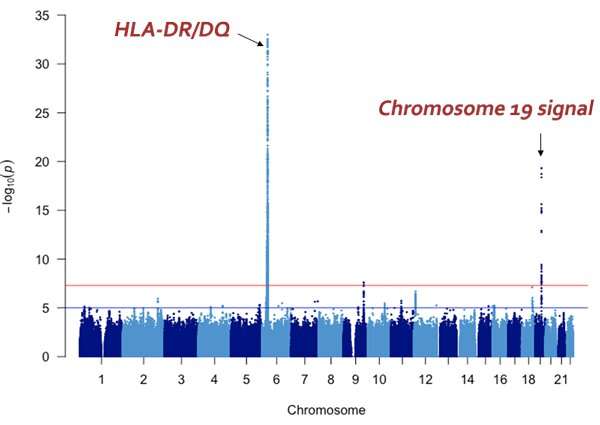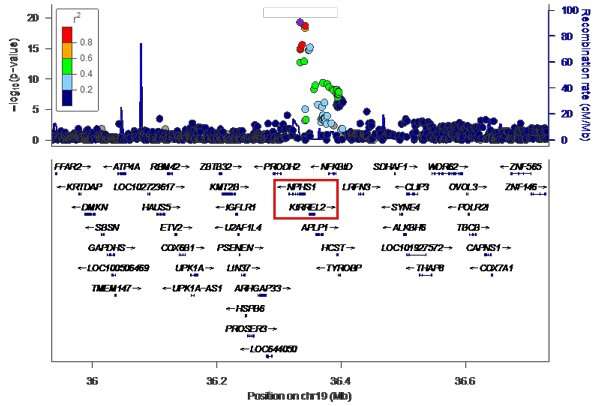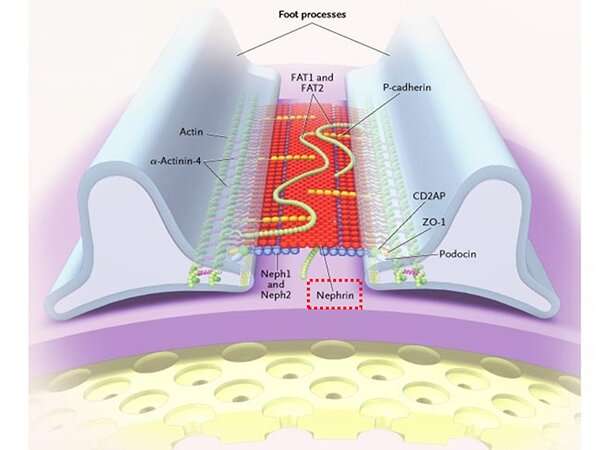Figure 1: Manhattan Plot of the Genome-wide Association Study:The vertical axis shows the P values (-log10) for each SNP, obtained from the GWAS of healthy participants and patients with steroid-sensitive nephrotic syndrome. The position of the chromosomes is plotted on the horizontal axis; identifying the genome-wide significant (P< 5x10-8) signal from chromosome 19. Credit: Kobe University
An international research collaboration, including Professor Iijima Kazumoto et al. (of the Department of Pediatrics, Kobe University Graduate School of Medicine) has revealed that NPHS1 is a disease-susceptibility gene for steroid-sensitive nephrotic syndrome in children. The NPHS1 gene encodes nephrin, a component protein for the renal glomerulus slit diaphragm, which prevents protein from being passed in the urine. It is expected that these successful results will contribute towards understanding of the underlying mechanism and the development of new treatments for childhood nephrotic syndrome.
Childhood nephrotic syndrome is the most common chronic kidney disease affecting children; in Japan it occurs at a yearly rate of 6.49 children out of every 100,000 (approximately 1,000 cases countrywide). It is a disease with unclear causes in which excessive amounts of protein are passed in the urine, resulting in severely low levels of protein in the blood. In Japan, it has been classified as both a specific pediatric chronic disease and a designated intractable disease. Between 80-90% of childhood nephrotic syndrome cases are steroid-sensitive nephrotic syndrome, meaning that they can be sent into complete remission through steroid treatment. However, about 20% of patients experience repeated relapses even in adulthood. There is a strong demand to illuminate the disease's causes and pathology, and utilize this knowledge to develop a definitive treatment method.
The majority of steroid-sensitive nephrotic syndrome cases are multifactorial. It is thought to occur due to a combination of some kind of genetic factor (disease-susceptibility gene) and an immunological trigger, such as an infection. Professor Iijima's research up until now has revealed that HLA-DR/DQ is a disease-susceptibility gene, however susceptibility genes outside the HLA region have yet to be illuminated.
Figure 2: Enlarged image of the genome-wide significance of regions on chromosome 19: This is an enlarged version of part of Figure 1 with the genetic regions narrowed down. It can be seen that the NPHS1-KIRREL2 region (indicated by the red box) on chromosome 19 has genome-wide significance. Credit: Kobe University
The research group has so far collected genomic DNA from around 1,300 patients with childhood nephrotic syndrome, with the cooperation of pediatric nephrology specialists across Japan. For this particular research, they used samples from 987 of the above cases that were childhood steroid-sensitive nephrotic syndrome with samples from 3,206 healthy Japanese donors as a control. GWAS was performed using the SNP array "Japonica," which is the most appropriate for carrying out this genetic test on Japanese individuals. From these results, variants in the NPHS1-KIRREL2 region on chromosome 19 (19q13.12) with genome-wide significance were identified (Figures 1 and 2). These variants are outside the HLA-DR/DQ region.
Trans-ethnic replication studies into these multiple variants in the NPHS1-KIRREL2 region were conducted across various populations, including Korean, South Asian, African, European, Hispanic and Maghrebian (Northwest African). The investigation covered patients with steroid-sensitive nephrotic syndrome (1,063 people in total) and healthy counterparts of the same ethnicity (19,729 people in total). The results were replicated in the Korean, South Asian and African datasets. An international meta-analysis including the Japanese cohort also illuminated the significance of these multiple variants in NPHS1.
Subsequently, the relationship between these multiple variants in NPHS1 and NPHS1 mRNA expression in the glomerulus was investigated. The NPHS1 mRNA expression originating from chromosomes with haplotypes containing all the risk variants was low, revealing that these variants play a role in NPHS1 mRNA regulation.
-
Credit: CC0 Public Domain
-
Figure 3: Renal glomerulus slit diaphragm and podocyte foot processes: The renal glomerulus slit diaphragm is located in-between the podocyte foot processes and functions as a barrier to prevent protein entering the urine. Nephrin (indicated by the red box), is the most important component protein for the formation of the renal glomerulus slit diaphragm and NPHS1 is the gene that encodes nephrin. (Slightly altered version of: Tryggvason K et al. Hereditary Proteinuria Syndromes and Mechanisms of Proteinuria. N Engl J Med 2006; 354:1387-1401, Fig.5. Components of the Slit-Diaphragm Protein Complex That Form a Porous Slit-Diaphragm Filter.). Credit: Kobe University
NPHS1 is the gene responsible for encoding nephrin. Nephrin is the most important protein for the formation of the renal glomerulus slit diaphragm, which acts as a barrier against urinary proteins (Figure 3). It is widely known that NPHS1 is the gene that causes congenital nephrotic syndrome Finnish type, a rare Mendelian genetic disorder.
This research study revealed that NPHS1 is also a disease-susceptibility gene for steroid-sensitive nephrotic syndrome, the most commonly occurring multifactorial kidney disorder in children.
This research represents an important milestone in our understanding of the genetics behind steroid-sensitive nephrotic syndrome's mechanism. It will also bring about a paradigm shift in the field of nephrology. These results will contribute towards the illumination of the pathology of childhood nephrotic syndrome. It is hoped that such knowledge could be applied to the development of new treatment methods.
Next, the researchers will investigate the link between HLA and nephrin. They aim to develop more effective, safe treatment and prevention methods for steroid-sensitive nephrotic syndrome while illuminating the causes and pathology behind the disease.
More information: Xiaoyuan Jia et al. Common risk variants in NPHS1 and TNFSF15 are associated with childhood steroid-sensitive nephrotic syndrome, Kidney International (2020). DOI: 10.1016/j.kint.2020.05.029
Journal information: Kidney International
Provided by Kobe University



























